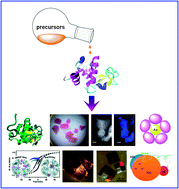Protein-directed approaches to functional nanomaterials: a case study of lysozyme†
Abstract
Functional nanomaterials have found wide applications in diverse areas because of their intrinsically different properties compared to their bulk counterparts. To achieve the goal of preparing functional nanomaterials, various strategies have been successfully developed. Among them, the biomolecule-directed approach has been extensively explored to synthesize many functional nanomaterials owing to their programmability, self-assembly and recognition capabilities. This Feature Article highlights the use of lysozyme as a model protein to the direct synthesis of nanomaterials. Future advances in rational de novo design and synthesis of functional nanomaterials with proteins will depend on a deep understanding of the synthetic strategies and the formation mechanisms. This Feature Article discusses the synthesis of nanomaterials with lysozyme in both the solution phase and crystal form. The synthetic strategies, formation mechanisms and wide applications of several kinds of materials, such as metals, oxides, metal sulfides, and composites, are covered. The lessons from this case study will provide invaluable guidance in future materials design using proteins and other biomolecules. Rational design of personalized functional nanomaterials will be possible in the future (366 references).


 Please wait while we load your content...
Please wait while we load your content...